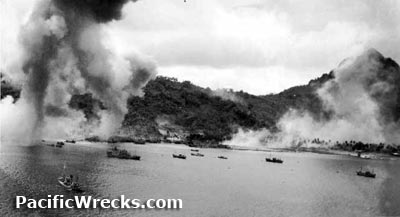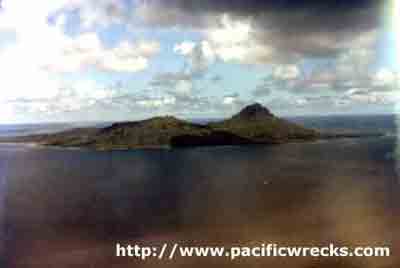|
|
|
|
| Missing In Action (MIA) | Prisoners Of War (POW) | Unexploded Ordnance (UXO) |
| Chronology | Locations | Aircraft | Ships | Submit Info | How You Can Help | Donate |
|
 USN c1944  Dick Williams 1982 |
Location Lat 07°22.36′N Long 151°52.30′E Dublon Island is part of the Southern Nomoneas Islands (South Shiki) in Truk Lagoon in Chuuk State (Truk) in the Federated States of Micronesia. Named "Dublon" by the Spanish for the island's resemblance to a dublon coin. Known as "Tonoas" or "Tonowas" in the local language. Known to the Japanese as Natsu Shima (Natsushima) meaning "Summer Island". To the north is Moen Island (Weno). To the south is Truk Harbor and Eten Island (Etten, Etan). To the southwest is Fefan Island. To the east was Natshushima Anchorage and further to the east is the edge of the outer reef. Prewar During November 1940, Japan developed Dublon into an Imperial Japanese Navy (IJN) base, building a headquarters building, eight barracks, five garages and a hospital. The area to the east of Dublon Island was known as the Natshushima Anchorage. The Japanese administration established a large settlement on the island known as Dublon Town that included trade stores, restaurants and geisha houses to support the Navy base. Wartime History During November 1943, the Japanese Navy Fourth Fleet HQ was built a large central concrete building, plus three large and nine smaller buildings. Facilities were manned by the 41st Naval Guard Unit. Forth Fleet Hospital could care for 850 patients in 5 wards and 24 other smaller buildings. 12 Concrete water reservoirs, an ice house, dental clinic, pharmacy, three warehouses and research lab existed. Naval Construction Department included 10,000 men at its peak. The main radio station of the five in the islands was located at Dublon, where several concrete receivers shelters and buildings were constructed. Forth Harbor Department was located on the southeastern part of the island near Dublon Town. It was 22 wooden buildings including repair shops, warehouses and barracks. South Seas Development Company had docking facilities on the southwestern tip of the island. Its supply storage and fish cannery were commandeered by the Navy, and it became the Fourth Naval Dockyard. It was the main receiving area for the military. More warehouses and a refrigeration building, HQ, and a two story barracks were constructed. A thousand men worked here on ship repairs, mostly damage sustained to ships from American submarine attacks. The facility also had a 30 ton floating crane and 2,500 ton dry dock. Nearby was a sawmill, and small rail cars connected most of the buildings. The Truk transportation department loaded and unloaded supplies from vessels in the anchorage. Since there were no docks for the larger ships, supplies needed to be ferried to larger ship then moved ashore. A derrick, carts, 40 trucks, barges, harbor craft, tugs and sampans were used for these purposes. During November 1943 the Imperial Japanese Army (IJA) 52nd Division "Oak" was based at Dublon until January 1944. There were not enough buildings for the troops and they were forced to camp in tents, and in civilian houses and schools. These Army troops were cut off from supply after they arrived and had to rely on the Navy. Their personnel built most of the land defenses on Dublon. American missions against Dublon March 15, 1944–May 27, 1945 Starting in the middle of March 1944, U.S. bombers from the 13th Air Force (13th AF) and later the 7th Air Force (7th AF) commenced strikes against Dublon and shipping offshore. During May 1945, land based P-47 Thunderbolts began strafing mission. The Japanese occupied Dublon Island until the official surrender of Japan on September 2, 1945. Dublon Seaplane Base Built by the Japanese 85th Submarine Base On the western shore was the 85th Submarine base, constructed during May 1942. It serviced, supplied and did minor repairs to subs. Torpedoes were stored in caves and transported by rail car to the shore. Many different repair and barracks existed specific to submarines. Japanese Army Headquarters The Japanese built an underground bunker used as a headquarters. Today located near Roro village. Nominated for the National Register of Historic Places as historic site "Japanese Army Headquarters" accepted Setember 30, 1976. Japanese Grave Markers Numerous markers on the island. Grave No. 1, Grave No. 2 and Grave No. 3. Japanese Hospital Built by the Japanese Navy during November 1940. hospital are easy to locate, as are water and fuel storage tanks, and signposts written in Japanese. Dick Williams adds: "Hospital where an American aviator POW met his end. He was kept in the room at the far right. Read his account in "Ghost Ships" Silander Manuel, a Mortlockese who taught me Trukese told me about him that they also slit his eyelids so that his eyes could never close again. This just before they killed him. That's what Richard, the orderly who went to Saipan to testify against the Japanese, told me they did with them. References WWII Wrecks of the Truk Lagoon pages 13, 19-22, 24 (map) 25 (map target area D-1), 26 (photos), 27 (map target area D-2), 28 (map target D-3), 29 (map 104 Air Force Arsenal -Navy), 30 (map Dublon Seaplane Base), 31 (map target D-4), 32 (map target D-4), 33, 34 (photo), 35 (map 4th comm unit transmitting station), 36 (photo target D-5), 37 (map Nanko dock area), 38 (map 38 4th ship repair area), 39 (photo 4th ship repair area), 40 (map target D-6), 41 (map sub base), 42 (photos storage caves), 43 (map target D-7), 44 (map target D-8), 45 (photo), 46 (map 4th Naval hospital), 47 (map target D-9), 49 (map target D-10), 49, 503-504 (index) Truk Lagoon Aera Study - Table D: World War II Sites and Features on Dublon NARA Federated States of Micronesia SP Japanese Army Headquarters National Registry of Historic Places Inventory - Japanese Army Headquarters June 21, 1976 [PDF] Contribute
Information Last Updated
|
Map Feb 4, 1944 Map Dublon D-10 |
| Discussion Forum | Daily Updates | Reviews | Museums | Interviews & Oral Histories |
|